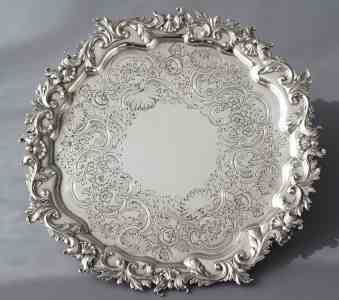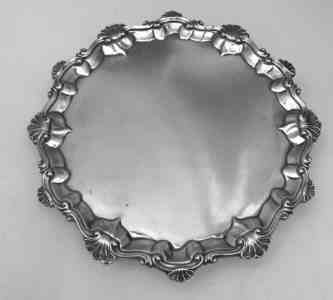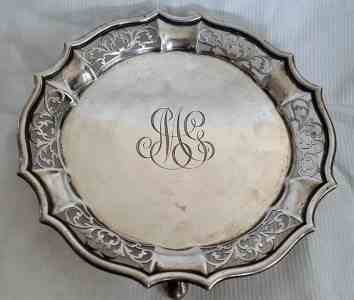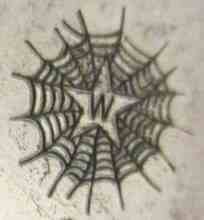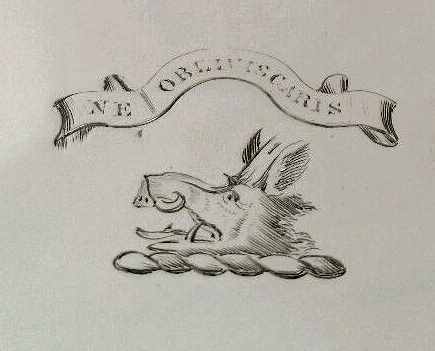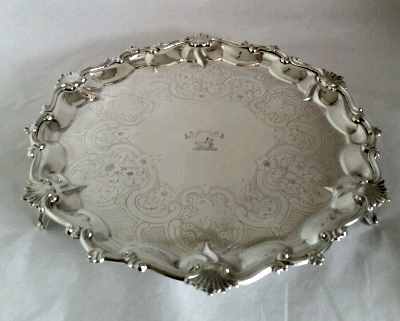
|
||||
YOUR GUIDE TO AUGUST NEWSLETTER:
new members
members' window
mail to ASCAS
replies to questions
a page per month
a silversmith per month
a word per month |

MARKS OF EUROPEAN SILVER PLATE: XV. WÜRTTEMBERGISCHE METALLWARENFABRIK (WMF) Marks of Cutlery & Napkin Rings The latest investigation of Dr. David N. Nikogosyan is a tremendous step forward in the understanding of marks on the silver-plated items produced by Wurtemberg Metalware Factory (WMF). Together with more precise dating of the already known stamps of this company, the author managed to identify a whole new class of marks used for export products made especially for the UK/USA and Austria-Hungary markets. This breakthrough was simultaneously achieved for both hollow ware and cutlery. In addition, the author discovered so-called "small marks" on hollow ware which were used when there was not enough space for customary marking. Concerning cutlery products, Dr. D.N. Nikogosyan described for the first time the marks on napkin rings, and identified the Art Deco ostrich mark, used for the items of higher artistic quality. The total number of mark photos has been increased from 94 to 169 for hollow ware products and from 103 to 150 for cutlery and napkin rings. click here |
Mail to ASCAS: e-mail
silverassociation@yahoo.itPaul N Whitaker writes:
...I've been told by someone this is Walker & Hall. It is off a walking cane.
I was just curious for your thought?
Any info appreciated greatly. Thanks for your time.
Paul N Whitaker
In my opinion the mark refers to Leslie James Anthony Hartley trading as The Wayne Hart Co.
They were manufacturing and wholesale jewellers, active at Warstone Lane, Birmingham . They registered a similar mark in 1945 at Chester Assay Office.
I'm unable to decrypt the inscription in the rectangle. Missing other marks (lion passant, date letter, town) I presume it's silverplate and not sterling silver
Giorgio Busetto
Maria Entrup-Henemann writes:
...thank you for always providing a newsletter with interesting articles and a lot of information.
Now I have a question to the ASCAS members (I think a few of them have special knowledge about Russian hallmarks): The pictures enclosed show a Moscow salt, but I cannot find any information on the silversmith (Cyrillic letters like "Peus"?)
Maybe somebody has any helpful hints.
Many thanks and kindest regards
Maria Entrup-Henemann
According to Postnikova-Loseva book this mark have a connection with those of Konstantin Pyets, Moscow 1835-1875 (the book is written in Russian and I'm unable to translate the reference -click here- )
Giorgio Busetto
Roslyn Zelenka writes:
...Can you help me with identifying these two silver pieces, I only know that they are from Austria.
Thanks.
Roslyn Zelenka
I'm unable to well read the town letter on Diana mark (bottom right).
If the letter is "A" (Vienna) I find various makers using similar HS or SH mark. Possibly the mark refers to Hermann Schwertner -click here- .
If the date letter is "B" (Lienz), sorry I don't have information
Giorgio Busetto
Andrew J. Brasch writes:
...Could you help me who is the maker? The letters are F.W.O.E
Thanks so much for your assistance
Andrew J. Brasch
Derek Jones writes:
...Here is something that may be of interest to include in a newsletter, however I let you be the judge as to it's suitability.
So , here is the story ......
I obtained this article from eBay where it was listed as a "mystery object" with the seller stating that they had no idea as to its use and that there was obviously a missing part to fit into the vertical slot.
I had never seen another like it in years of searching the world wide sites of silver but had an idea that it might be a desk accessory to hold a wax stick holder, one of which I already had.
I was pleased to find that wax stick & holder did indeed fit into the vertical slot but have been wondering if in fact that is what the "mystery object" was designed for as silversmiths of that era turned out some weird & wonderful
pieces to display their craftsmanship.
I would be pleased if you or your members would have any knowledge of the object and indeed if there is another use for it.
Made by Chrisford & Norris Birmingham 1909.
Thank you,
Derek Jones
Novelties were in great fashion in early 1900.
Undoubtedly a desk accessory and the box could be a stamp holder.
Possibly the stick holder is oversized in relation to the object
Giorgio Busetto
"A PAGE per MONTH"
In this column we presents a page obtained from makers'
brochures, books, auction catalogs, advertising or whatever
other printed paper, related to silver, that may be of interest
for ASCAS members.
The images will be published at a "low resolution" level and for
private and personal use only.
This column is published under the kind permission of Giorgio
Busetto's website
OTHER SILVER ADVERTISEMENTS

This month ASCAS presents an 1892 advertisement of
GEO.W.HICKOX
Santa Fé, New Mexico
Scarce information is available about this firm. In an 1892 advertisement the firm presents itself as the "Mexican Filagree Jewelers, Santa Fé, New Mexico. Manufacturers of Filagree Souvenir Spoons and everything in the Filagree line".
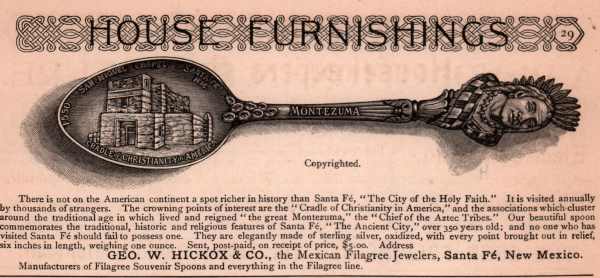
"A WORD per MONTH"
In this column we present an abstract from a page of the "What is? Silver Dictionary"
courtesy of


SALVER - WAITER - CARD TRAY
The earliest known mention of such a piece is in 1661, wherein it is described as follows "...salver is a new fashioned piece of wrought plate, broad and flat, with a foot underneath, and is used in giving beer, or other liquid thing to save the Carpit or Cloathes from drops..."
Originally they stand on a foot underneath but within a short time they left place to the more attractive shapes on three or four short feet.
Salvers occur in various sizes and shapes. being basically circular but in some cases square or polygonal with rounded corners (rare triangular examples are also known).... MORE...
"A SILVERSMITH per MONTH"
In this column
we present marks, information and history of silversmiths and
silver manufacturers.
This column is published under the kind permission of Giorgio
Busetto's website

E.G. WEBSTER & SON
The firm of Elizur G. Webster began the silverplating activity at 175 Broadway, NY in 1860.
In 1864 E.G. Webster entered in partnership with William Dupree forming the firm Webster & Dupree active at 447 Broome (serving probably as the factory of the business).
In 1865, Adelbert A. Webster joined his brother forming E.G. Webster & Brother active at 14 Maiden Lane.
The activity of Webster & Dupree continued at 447 Broome until c. 1866 when presumably became the factory of the new Webster Manufacturing Co (Dupree remained in the business as factory's superintendent). The location at 14 Maiden Lane became the firm's showroom.
In 1867 the Webster Manufacturing Co was incorporated with E.G. Webster as president and A.A. Webster as secretary but in 1875 the firm changed its name back to E.G. Webster & Brother.....
MORE...
"A CREST per MONTH"
In this column we
present images and descriptions of Crests and Mottoes of British,
Irish and Scottish families as engraved on silver items.
This column is published under the kind permission of Giorgio
Busetto's website

FAMILY CRESTS: LIST OF NAMES
ILLUSTRATED DIRECTORY OF FAMILY CRESTS
CAMPBELL - LORN - MC'TAVISH
The crest of Robert-Nutter Campbell, Esq. of Ormidale Argylll and of Lorn and M'Tavish families (Scotland)
The Latin motto is 'Ne obliviscaris' (you must not forget)
The crest is described as 'a boar's head, couped'
The crest was found on a circular form silver salver hallmarked London 1801, maker William Bennett
"A YEAR per MONTH"
FROM SHEFFIELD ASSAY OFFICE REGISTER
- 1779 -
This table is obtained from The Book of Entries of the Names, Places of abode and Marks of the several Silversmiths and Plate Workers residing in Sheffield, or within twenty miles thereof, who are required to send their goods to the Assay Office, lately established in the Town of Sheffield by an Act of Parliament lately passed in the Thirteenth Year of the Reign of King George the Third intituled:
An Act for appointing Wardens and Assaymasters for
Assaying Wrought Plate in the Towns of Sheffield
and Birmingham
YEAR 1779


Closing our August 2017 edition of ASCAS Newsletter I hope
you have appreciated its content.
Your comments, suggestions and advice will be of great help.
My thanks to Andrew J. Brasch, Maria Entrup-Henemann, Derek Jones, David McKinley, Maurice Meslans, David N. Nikogosyan, Paul N Whitaker and Roslyn Zelenka for their precious contributions.
Giorgio Busetto
Secretary
DISCLAIMER AND PRIVACY POLICY
ASCAS is a community of people having a common
interest in antique silver.
It is a non-profit association without commercial links.
Membership is open to whomever has a true interest in
this subject matter.
ASCAS has no real property and no fees are requested nor
accepted from members.
ASCAS keeps in touch with its members only through
periodical newsletters, e-mails and web-site updating
and ignores and is not responsible for any other
activity pursued by its members.
Likewise, ASCAS is not responsible for opinions,
evaluation and images displayed, and in any form
published or supplied for publication, by its members
who, in any case, maintain the property of their works
and assure the respect of national and international
legislation about Intellectual Property.
ASCAS does not have the full addresses of its members (only
town, country and e-mail address are requested for
membership).
ASCAS handles and protects with care its members' e-mail
addresses, will not disclose the addresses to third
parties, will use this information only to reply to
requests received from members and for communications
strictly related to its activity.
These rules are expressly accepted by submitting the
membership request.

"A WORD per MONTH"
In this column we present an abstract from a page of the "What is? Silver Dictionary"courtesy of
SALVER - WAITER - CARD TRAY
The earliest known mention of such a piece is in 1661, wherein it is described as follows "...salver is a new fashioned piece of wrought plate, broad and flat, with a foot underneath, and is used in giving beer, or other liquid thing to save the Carpit or Cloathes from drops..."
Originally they stand on a foot underneath but within a short time they left place to the more attractive shapes on three or four short feet.
Salvers occur in various sizes and shapes. being basically circular but in some cases square or polygonal with rounded corners (rare triangular examples are also known).... MORE...
"A SILVERSMITH per MONTH"
In this column
we present marks, information and history of silversmiths and
silver manufacturers.
This column is published under the kind permission of Giorgio
Busetto's website

E.G. WEBSTER & SON
The firm of Elizur G. Webster began the silverplating activity at 175 Broadway, NY in 1860.
In 1864 E.G. Webster entered in partnership with William Dupree forming the firm Webster & Dupree active at 447 Broome (serving probably as the factory of the business).
In 1865, Adelbert A. Webster joined his brother forming E.G. Webster & Brother active at 14 Maiden Lane.
The activity of Webster & Dupree continued at 447 Broome until c. 1866 when presumably became the factory of the new Webster Manufacturing Co (Dupree remained in the business as factory's superintendent). The location at 14 Maiden Lane became the firm's showroom.
In 1867 the Webster Manufacturing Co was incorporated with E.G. Webster as president and A.A. Webster as secretary but in 1875 the firm changed its name back to E.G. Webster & Brother.....
MORE...
"A CREST per MONTH"
In this column we
present images and descriptions of Crests and Mottoes of British,
Irish and Scottish families as engraved on silver items.
This column is published under the kind permission of Giorgio
Busetto's website

FAMILY CRESTS: LIST OF NAMES
ILLUSTRATED DIRECTORY OF FAMILY CRESTS
CAMPBELL - LORN - MC'TAVISH
The crest of Robert-Nutter Campbell, Esq. of Ormidale Argylll and of Lorn and M'Tavish families (Scotland)
The Latin motto is 'Ne obliviscaris' (you must not forget)
The crest is described as 'a boar's head, couped'
The crest was found on a circular form silver salver hallmarked London 1801, maker William Bennett
"A YEAR per MONTH"
FROM SHEFFIELD ASSAY OFFICE REGISTER
- 1779 -
This table is obtained from The Book of Entries of the Names, Places of abode and Marks of the several Silversmiths and Plate Workers residing in Sheffield, or within twenty miles thereof, who are required to send their goods to the Assay Office, lately established in the Town of Sheffield by an Act of Parliament lately passed in the Thirteenth Year of the Reign of King George the Third intituled:
An Act for appointing Wardens and Assaymasters for
Assaying Wrought Plate in the Towns of Sheffield
and Birmingham
YEAR 1779


Closing our August 2017 edition of ASCAS Newsletter I hope
you have appreciated its content.
Your comments, suggestions and advice will be of great help.
My thanks to Andrew J. Brasch, Maria Entrup-Henemann, Derek Jones, David McKinley, Maurice Meslans, David N. Nikogosyan, Paul N Whitaker and Roslyn Zelenka for their precious contributions.
Giorgio Busetto
Secretary
DISCLAIMER AND PRIVACY POLICY
ASCAS is a community of people having a common
interest in antique silver.
It is a non-profit association without commercial links.
Membership is open to whomever has a true interest in
this subject matter.
ASCAS has no real property and no fees are requested nor
accepted from members.
ASCAS keeps in touch with its members only through
periodical newsletters, e-mails and web-site updating
and ignores and is not responsible for any other
activity pursued by its members.
Likewise, ASCAS is not responsible for opinions,
evaluation and images displayed, and in any form
published or supplied for publication, by its members
who, in any case, maintain the property of their works
and assure the respect of national and international
legislation about Intellectual Property.
ASCAS does not have the full addresses of its members (only
town, country and e-mail address are requested for
membership).
ASCAS handles and protects with care its members' e-mail
addresses, will not disclose the addresses to third
parties, will use this information only to reply to
requests received from members and for communications
strictly related to its activity.
These rules are expressly accepted by submitting the
membership request.
Originally they stand on a foot underneath but within a short time they left place to the more attractive shapes on three or four short feet.
Salvers occur in various sizes and shapes. being basically circular but in some cases square or polygonal with rounded corners (rare triangular examples are also known).... MORE...
"A SILVERSMITH per MONTH"
In this column
we present marks, information and history of silversmiths and
silver manufacturers.
This column is published under the kind permission of Giorgio
Busetto's website

E.G. WEBSTER & SON
The firm of Elizur G. Webster began the silverplating activity at 175 Broadway, NY in 1860.
In 1864 E.G. Webster entered in partnership with William Dupree forming the firm Webster & Dupree active at 447 Broome (serving probably as the factory of the business).
In 1865, Adelbert A. Webster joined his brother forming E.G. Webster & Brother active at 14 Maiden Lane.
The activity of Webster & Dupree continued at 447 Broome until c. 1866 when presumably became the factory of the new Webster Manufacturing Co (Dupree remained in the business as factory's superintendent). The location at 14 Maiden Lane became the firm's showroom.
In 1867 the Webster Manufacturing Co was incorporated with E.G. Webster as president and A.A. Webster as secretary but in 1875 the firm changed its name back to E.G. Webster & Brother.....
MORE...
"A CREST per MONTH"
In this column we
present images and descriptions of Crests and Mottoes of British,
Irish and Scottish families as engraved on silver items.
This column is published under the kind permission of Giorgio
Busetto's website

FAMILY CRESTS: LIST OF NAMESILLUSTRATED DIRECTORY OF FAMILY CRESTS
CAMPBELL - LORN - MC'TAVISH
The crest of Robert-Nutter Campbell, Esq. of Ormidale Argylll and of Lorn and M'Tavish families (Scotland)
The Latin motto is 'Ne obliviscaris' (you must not forget)
The crest is described as 'a boar's head, couped'
The crest was found on a circular form silver salver hallmarked London 1801, maker William Bennett
"A YEAR per MONTH"
FROM SHEFFIELD ASSAY OFFICE REGISTER
- 1779 -
This table is obtained from The Book of Entries of the Names, Places of abode and Marks of the several Silversmiths and Plate Workers residing in Sheffield, or within twenty miles thereof, who are required to send their goods to the Assay Office, lately established in the Town of Sheffield by an Act of Parliament lately passed in the Thirteenth Year of the Reign of King George the Third intituled:
An Act for appointing Wardens and Assaymasters for
Assaying Wrought Plate in the Towns of Sheffield
and Birmingham
YEAR 1779


Closing our August 2017 edition of ASCAS Newsletter I hope
you have appreciated its content.
Your comments, suggestions and advice will be of great help.
My thanks to Andrew J. Brasch, Maria Entrup-Henemann, Derek Jones, David McKinley, Maurice Meslans, David N. Nikogosyan, Paul N Whitaker and Roslyn Zelenka for their precious contributions.
Giorgio Busetto
Secretary
Assaying Wrought Plate in the Towns of Sheffield
and Birmingham
YEAR 1779

|

|
Your comments, suggestions and advice will be of great help.
My thanks to Andrew J. Brasch, Maria Entrup-Henemann, Derek Jones, David McKinley, Maurice Meslans, David N. Nikogosyan, Paul N Whitaker and Roslyn Zelenka for their precious contributions.
Giorgio Busetto
Secretary
DISCLAIMER AND PRIVACY POLICYASCAS is a community of people having a common
interest in antique silver.
|


















